Pollen-collecting by stingless bees on cacao flowers
I came across this very interesting abstract from a study of cacao pollination by meliponine bee Liotrigona parvula Darchen in Africa,(which would be a stngless bee species at least related to those found in Central and South America!).I have been interested in just how many stingless bees might exist in the so called 'Old World' including Africa.I had already been aware that stingless bees exist in Australia and were a source of honey for the Aborigenes.Also someone from Japan had told me that there were stingless bees in South East Asia,particularly Thailand.What is new and exciting to me and no doubt to most people interested in cacao is that stingless bees may contribute however slightly or not,to cacao pollination in Africa and I have just come across a similar claim being made by an investigator in Central America that another stingless bee species has been shown to pollinate cacao in Costa Rica and is competitive in that task with its midge or fly competitors,at least in situations where cacao is growing in direct sunlight !
Excuse the exclamation marks but this stingless bee-cacao pollination is big news and,even for most cacao experts,new news.If true it would show that at least one stingless bee can do the pollination of cacao generally believed done only by tiny flies or midges ! While the African observer appears to be saying that the stingless bee Liotrigona parvula Darchenmay may very well be contributing to cacao pollination in cacao plantations,the Costa Rica observers appear to be saying the stingless bee taking pollen in diect sunlight in competition with midges may not be pollinating at all.Still stingless bees do pollinate other trees and crops and are valuable to a diverse ecology including in cacao agro-ecosystems and even if the stingless bee took pollen back to its nest it most likely is at least rarely or not,contributing to cacao pollination there as well..
http://journals.cambridge.org/actiion/displayAbstract;jsessionid=8D1F87A9AD1AFA5B7A1C53FF2DC8EB40.journals?fromPage=online&aid=5981784
Research Paper Dynamics of cocoa pollination: tools and applications for surveying and monitoring cocoa pollinators
E.A. Frimponga1 c1, I. Gordona2, P.K. Kwaponga1 and B. Gemmill-Herrena3 a1 Department of Entomology and Wildlife, School of Biological Sciences, University of Cape Coast, Cape Coast, Ghana a2 icipe – African Insect Science for Food and Health, PO Box 30772-00100, Nairobi, Kenya a3 AGPS – FAO, Viale Terme di Caracalla, Rome, Italy
Abstract
Pollinators are important natural agents for fruit and seed formation in most tree crops and the use of appropriate sampling methods is fundamental in studying their population. A study to develop surveying and monitoring protocols for cocoa pollinators was undertaken in Ghana. Yellow, white and blue UV-bright painted pan traps (UVPPT), McPhail traps and motorized aspirators were used to sample pollinators of cocoa for 13 successive months, after 6 days assessment of the effectiveness of the traps and diurnal active period of the pollinators. The peak pollinating period of cocoa by ceratopogonid midges was between 07.00 and 12.00 h, as previously reported. All three methods were effective in sampling ceratopogonid midges with the UVPPT being the most efficient in terms of sampling effort. The number of ceratopogonid midges caught by the yellow-UVPPT was significantly higher than that by blue- and white-UVPPT. The diversity of midges caught could not be determined due to taxonomic difficulties, and thus all the three colours of UVPPT should be used until efficiency in terms of diversity is determined. It is reported here that the meliponine bee Liotrigona parvula Darchen visits cocoa flowers and thus their effectiveness in cocoa pollination should be investigated. ..................................................
E.A. Frimponga1 c1, I. Gordona2, P.K. Kwaponga1 and B. Gemmill-Herrena3 a1 Department of Entomology and Wildlife, School of Biological Sciences, University of Cape Coast, Cape Coast, Ghana a2 icipe – African Insect Science for Food and Health, PO Box 30772-00100, Nairobi, Kenya a3 AGPS – FAO, Viale Terme di Caracalla, Rome, Italy
Abstract
Pollinators are important natural agents for fruit and seed formation in most tree crops and the use of appropriate sampling methods is fundamental in studying their population. A study to develop surveying and monitoring protocols for cocoa pollinators was undertaken in Ghana. Yellow, white and blue UV-bright painted pan traps (UVPPT), McPhail traps and motorized aspirators were used to sample pollinators of cocoa for 13 successive months, after 6 days assessment of the effectiveness of the traps and diurnal active period of the pollinators. The peak pollinating period of cocoa by ceratopogonid midges was between 07.00 and 12.00 h, as previously reported. All three methods were effective in sampling ceratopogonid midges with the UVPPT being the most efficient in terms of sampling effort. The number of ceratopogonid midges caught by the yellow-UVPPT was significantly higher than that by blue- and white-UVPPT. The diversity of midges caught could not be determined due to taxonomic difficulties, and thus all the three colours of UVPPT should be used until efficiency in terms of diversity is determined. It is reported here that the meliponine bee Liotrigona parvula Darchen visits cocoa flowers and thus their effectiveness in cocoa pollination should be investigated. ..................................................
.......................
http://www.springerlink.com/content/t773gu0133132270/
Pollen-collecting by stingless bees on cacao flowers
Stingless bees (Trigona jaty) routinely visit the flowers ofTheobroma cacao (Sterculiaceae) in the Atlantic lowlands of Costa Rica. The bees collect pollen and behave as pollen thieves in flowers well exposed to direct sunlight in cacao plantations, and avoid flowers in heavy shade. Pollination rates are maximized, however, in heavy shade due to the high abundance of the small-bodied pollinating midges (Ceratopogonidae and Cecidomyiidae) found in such places. Pollen-thieving by stingless bees, therefore, may only impact on fruit set in cacao trees in direct sunlight, with only minimal to no impact in areas of cacao where natural pollinator activity is high.
Key words Trigona jaty - pollination - cacao - sunlight - shade
This research was funded by grants from The American Cocoa Research Institute of the United States of America. I thank T. Noeske for statistical assistance.
.........................................
google search 'stingless bees pollen honey production collecting'
https://www.google.com/search?hl=en&q=stingless+bees+pollen+honey+production++collecting&oq=stingless+bees+pollen+honey+production++collecting&aq=f&aqi=&aql=&gs_nf=1&gs_l=serp.12...19373.26156.0.27839.18.18.0.0.0.0.204.2856.1j16j1.18.0.t4CU6h8lMx8
Below is from an NGO group's website involved with stingless bees and honey in the Amazon.I have read estimates from 25 species to 400 species of stingless bees in the world to their estimate of 800 species !
Here in Guatemala over a couple of decades I have only encountered 2 species whose honey is available regularly to be sold to the public.One is a honey called miel blanca or 'white honey' that could potentially be domesticated rather than just robbing iyts honey in the wild as is common.The other is a honey called talnet
or talnete that is produced by a species of bee living beneath the ground and whose honey both looks like a red wine and is in fact just about as liquid as red wine or water.
While the bee responsible for miel blanca probably nests in trees and could be domseticated or semi-domesticated,unfortunately I belive the bees respobnsible for talnet honey live below ground and cannot to my knowledge be dometicated.The nest is apparently destroyed each time the honey is found
and perhaps the only solution is to identify the plants used by these bees and make special effort to educate those making a living by harvesting this honey in the wild,to respect and protect their food sources and to
not over harvest.
I was fascinated to learn from the article below that the Amazon has a stingless bee that is the size of the apis bee that we commonly get our honey from and use to pollinate our agricultural crops around the world.Also I concur with the fact that stingless bees generally produce a honey with a higher water content than apis bee honey and as I've said,the tanet honey here is about as liquid as water or wine.
http://www.melipona.org/about.html
Honey from stingless bees
About 800 species of stingless bees are found throughout tropical regions of the World, ranging from such ecologically diverse habitats as humid rainforest to dry savanna or cerrado. Their greatest diversity and abundance, however, is in the Amazonian rain forest. While they range in size from only a few mm to larger than the honey bee (Apis mellifera), they all live in colonies where they care for the brood (the new bees) laid by the colony mother, or queen. Some colonies contains thousands of individuals. Working females are constantly flying in and out of the colony to gather what is needed for sustaining the large family. Most importantly the foraging workers gather honey and pollen used as provision for the young bees (larvae) being reared. The bees will usually store a large amount of both honey and pollen during favorable times which they can use later. If properly managed, the honey can be harvested from the stingless bees without damaging or weakening the colony. The taste of stingless bee honey is experienced different by different people, but generally it is called very sweet and pleasant, almost acidic and with a boost of floral fragrances. The highly desired Tetragonisca honey is a little more acidic compared to honey from Melipona due to the plants visited by these bees...............
http://www.melipona.org/about.html
.........................................
google search 'stingless bees pollen honey production collecting'
https://www.google.com/search?hl=en&q=stingless+bees+pollen+honey+production++collecting&oq=stingless+bees+pollen+honey+production++collecting&aq=f&aqi=&aql=&gs_nf=1&gs_l=serp.12...19373.26156.0.27839.18.18.0.0.0.0.204.2856.1j16j1.18.0.t4CU6h8lMx8
Below is from an NGO group's website involved with stingless bees and honey in the Amazon.I have read estimates from 25 species to 400 species of stingless bees in the world to their estimate of 800 species !
Here in Guatemala over a couple of decades I have only encountered 2 species whose honey is available regularly to be sold to the public.One is a honey called miel blanca or 'white honey' that could potentially be domesticated rather than just robbing iyts honey in the wild as is common.The other is a honey called talnet
or talnete that is produced by a species of bee living beneath the ground and whose honey both looks like a red wine and is in fact just about as liquid as red wine or water.
While the bee responsible for miel blanca probably nests in trees and could be domseticated or semi-domesticated,unfortunately I belive the bees respobnsible for talnet honey live below ground and cannot to my knowledge be dometicated.The nest is apparently destroyed each time the honey is found
and perhaps the only solution is to identify the plants used by these bees and make special effort to educate those making a living by harvesting this honey in the wild,to respect and protect their food sources and to
not over harvest.
I was fascinated to learn from the article below that the Amazon has a stingless bee that is the size of the apis bee that we commonly get our honey from and use to pollinate our agricultural crops around the world.Also I concur with the fact that stingless bees generally produce a honey with a higher water content than apis bee honey and as I've said,the tanet honey here is about as liquid as water or wine.
http://www.melipona.org/about.html
Honey from stingless bees
About 800 species of stingless bees are found throughout tropical regions of the World, ranging from such ecologically diverse habitats as humid rainforest to dry savanna or cerrado. Their greatest diversity and abundance, however, is in the Amazonian rain forest. While they range in size from only a few mm to larger than the honey bee (Apis mellifera), they all live in colonies where they care for the brood (the new bees) laid by the colony mother, or queen. Some colonies contains thousands of individuals. Working females are constantly flying in and out of the colony to gather what is needed for sustaining the large family. Most importantly the foraging workers gather honey and pollen used as provision for the young bees (larvae) being reared. The bees will usually store a large amount of both honey and pollen during favorable times which they can use later. If properly managed, the honey can be harvested from the stingless bees without damaging or weakening the colony. The taste of stingless bee honey is experienced different by different people, but generally it is called very sweet and pleasant, almost acidic and with a boost of floral fragrances. The highly desired Tetragonisca honey is a little more acidic compared to honey from Melipona due to the plants visited by these bees...............
|
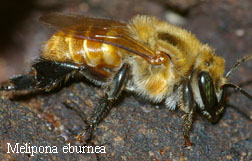
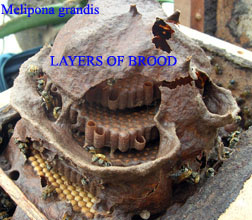
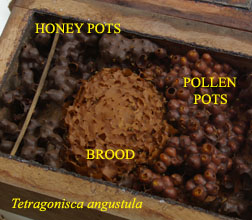
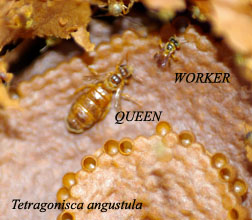
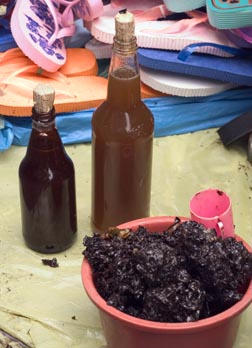
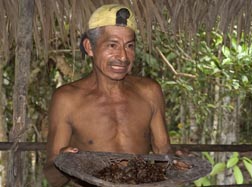
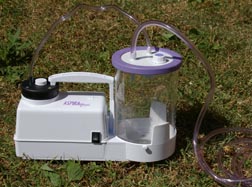





Hello Tony....We met several weeks ago in Antigua and I have some questions for you. If you would please email me at jtoddpope@gmail.com
ReplyDeleteThanks